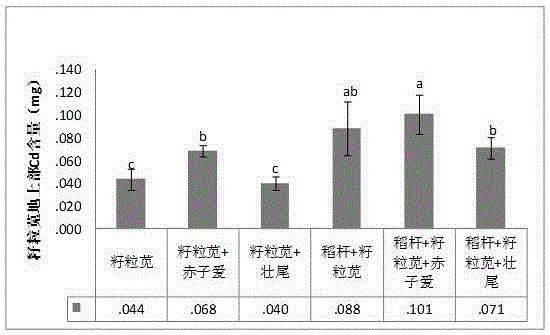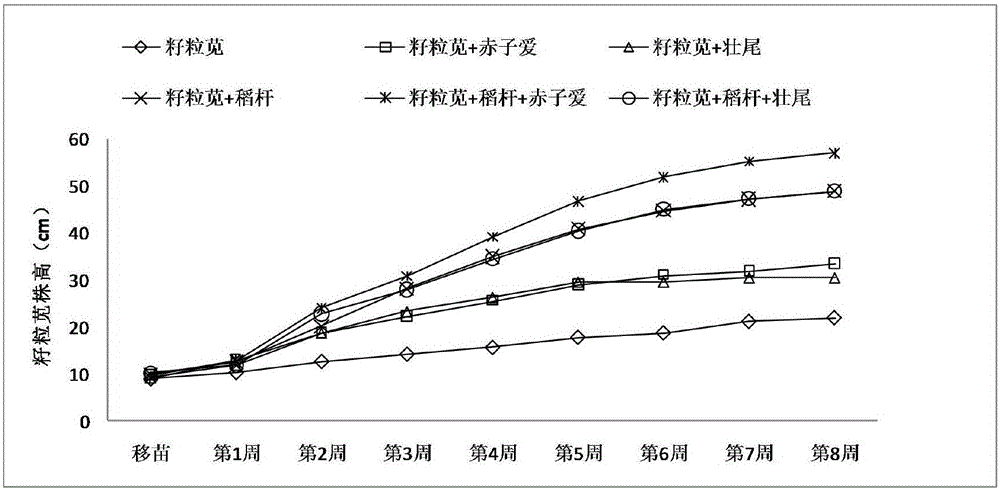Biological combined remediation method for heavy metal contaminated soil in acid diggings
A technology of polluted soil and joint remediation, applied in the field of soil remediation, can solve problems such as unsuitable direct planting of crops, poor quality environment, etc., and achieve the effect of avoiding secondary pollution problems, being extremely easy to obtain, and improving soil quality.
- Summary
- Abstract
- Description
- Claims
- Application Information
AI Technical Summary
Problems solved by technology
Method used
Image
Examples
Embodiment 1
[0033]1. Preparation of grain amaranth seedlings: grain amaranth is the introduced American grain amaranth K472, purchased from Dijing Landscaping Engineering Co., Ltd. Seeds of amaranth were cultured in a biochemical incubator (Pearl River, LRH-250A) at 25°C for 12 hours, and then sowed into seedling pots (specifications: aperture 5 cm, depth 8 cm). The seedling pots were placed in the greenhouse (average room temperature 30°C) and cultivated for 10 days. When the seedlings grew to about 10cm and the number of leaves was 5 pieces, the seedlings with strong and consistent growth were selected and transplanted into plastic flowerpots (mouth diameter 19cm, bottom diameter 14cm , 15cm high).
[0034] 2. Earthworm: Choose Zhuangwei Ringworm Amynthas robustus (referred to as strong tail) and Eisenia chinensis Eisenia fetida (Chiziai for short) is an earthworm for testing, Eisenia foetida selected from artificial breeding plants; Amynthas robustus It is a local species in So...
Embodiment 2
[0045] Effect of different treatments of embodiment 2 on the plant height of grain amaranth
[0046] Experimental method is with embodiment 1, and result is as figure 1 It was shown that the plant height of grain amaranth with different treatments began to be different at the second week, and the difference continued to widen with time (P figure 2 It is the plant height of grain amaranth with different treatments at the end of the two-month cultivation. From the figure, compared with group P, simply adding earthworms or straw (PE, PL, SA groups) could significantly increase the plant height of grain amaranth, and the plant height increased by 23-30% and 96%, respectively. The grain amaranth treated by SPE group grew the highest, which was 130% higher than that of P group. The effects of different treatment groups are: SPE>SPL, SA>PE, PL.
Embodiment 3
[0047] Effect of different treatments of embodiment 3 on dry weight of aboveground part of grain amaranth
[0048] Experimental method is with embodiment 1, and result is obtained by image 3 It was shown that, compared with the P group, simply adding earthworms or straw (PE, PL, SA groups) could significantly increase the dry weight of the aboveground part of amaranth grains, which increased by 90-94% and 382%, respectively. The shoot of amaranth treated with SPE was the heaviest, which was 477% higher than that of P group. The effect of different treatment groups is: SPE>SA>SPL>PE, PL.
PUM
 Login to View More
Login to View More Abstract
Description
Claims
Application Information
 Login to View More
Login to View More - R&D
- Intellectual Property
- Life Sciences
- Materials
- Tech Scout
- Unparalleled Data Quality
- Higher Quality Content
- 60% Fewer Hallucinations
Browse by: Latest US Patents, China's latest patents, Technical Efficacy Thesaurus, Application Domain, Technology Topic, Popular Technical Reports.
© 2025 PatSnap. All rights reserved.Legal|Privacy policy|Modern Slavery Act Transparency Statement|Sitemap|About US| Contact US: help@patsnap.com



